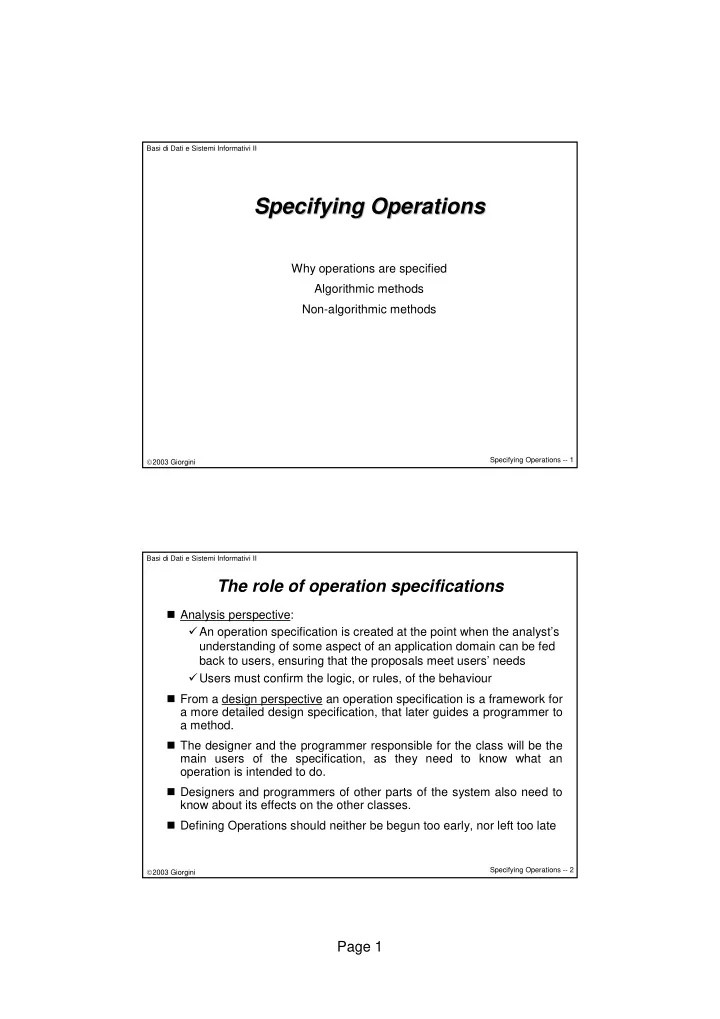

Basi di Dati e Sistemi Informativi II Specifying Operations Specifying Operations Why operations are specified Algorithmic methods Non-algorithmic methods 2003 Giorgini Specifying Operations -- 1 Basi di Dati e Sistemi Informativi II The role of operation specifications � Analysis perspective: � An operation specification is created at the point when the analyst’s understanding of some aspect of an application domain can be fed back to users, ensuring that the proposals meet users’ needs � Users must confirm the logic, or rules, of the behaviour � From a design perspective an operation specification is a framework for a more detailed design specification, that later guides a programmer to a method. � The designer and the programmer responsible for the class will be the main users of the specification, as they need to know what an operation is intended to do. � Designers and programmers of other parts of the system also need to know about its effects on the other classes. � Defining Operations should neither be begun too early, nor left too late 2003 Giorgini Specifying Operations -- 2 Page 1
Basi di Dati e Sistemi Informativi II Specification by Contract � Operations are defined primarily in terms of the services they deliver, and the ‘payment’ they receive � We identify the nature of the service provided by the server object, and what must be provided by the client object in order to obtain the service � The intent or purpose of the operation � The return type � An appropriate description of the logic � Other operations called, whether in the same object or in other objects � Events transmitted to other objects � Attributes set during the operation’s execution � The response to exceptions � Any non-functional requirements that apply 2003 Giorgini Specifying Operations -- 3 Basi di Dati e Sistemi Informativi II Describing Operation Logic � Non-algorithmic approaches: describing the logic of an operation as a black box � Decision table � Pre- and post conditions � Algorithmic approaches: braking the internal logic of a process into small steps � Structured English � Pseudo-code � Activity Diagrams 2003 Giorgini Specifying Operations -- 4 Page 2
Basi di Dati e Sistemi Informativi II Decision table 2003 Giorgini Specifying Operations -- 5 Basi di Dati e Sistemi Informativi II Pre- and post conditions � What conditions must be satisfied before an operation can take place? � What are the conditions that can apply after an operation is completed? � Ex: Campaign.assignStaff(creativeStaffObject.id) � Pre-condition: creativeStaffObject .id is valid � Post-condition: a link is created between campaignObject and creativeStaffObject 2003 Giorgini Specifying Operations -- 6 Page 3
Basi di Dati e Sistemi Informativi II Structured English do while there are more staff in the list calculate staff bonus store bonus amount begin case case bonus > £250 add name to ‘star of the month’ list case bonus < £25 print warning letter end case end do 2003 Giorgini Specifying Operations -- 7 Basi di Dati e Sistemi Informativi II Pseudo-code � It differs from Structured english in that it is closer to the vocabulary and syntax of a specific programming language. � Pseudo-code remains only a skeleton of a program, intended only to illustrate its logical structure without including full design and implementation details Activity diagrams � They are a part of UML notation set that can be used to specify the logic of procedurally complex operations � We will discuss them later. 2003 Giorgini Specifying Operations -- 8 Page 4
Basi di Dati e Sistemi Informativi II Object Constraint Language � Some constraints can be adequately expressed in the graphical language (e.g., Multiplicity of an association). � Some can not. For example, constraints within operation specifications (pre- and post-conditions) � Where great precision is required, OCL provides a formal language � OCL expressions are constructed from a collection of pre-defined elements and types � The language has a precise grammar that enables the construction of unambiguous statements 2003 Giorgini Specifying Operations -- 9 Basi di Dati e Sistemi Informativi II OCL features � A contex t that defines a domain within which the expression is valid (underlined for clarity). � A property of that instance which is the context for the expression. Properties may include attributes, association-ends and query operations. � An OCL operation that is applied to the property. Operations include the arithmetical operators (*,+,-,/) and logical operators (AND, OR, IMPLIES) 2003 Giorgini Specifying Operations -- 10 Page 5
Basi di Dati e Sistemi Informativi II OCL features 2003 Giorgini Specifying Operations -- 11 Basi di Dati e Sistemi Informativi II Pre- and Post-conditions in OCL Type::operation(parameter1:type, parameter2:type)return type pre: parameter1> … parameter2 = … post:result= … EX: CreativeStaff::changeGrade(id:String, grade.id:String, gradeChangeDate:Date) pre: self.id->notEmpty self.grade.id->notEmpty self.gradeChangeDate >= today (assumes no retrospective changes) post: staffGrade[grade.id]->exists self.staffGrade->notEmpty self.staffGrade[grade.id].previousGrade->notEmpty self.staffGrade.gradeFinishDate = gradeChangeDate :Boolean 2003 Giorgini Specifying Operations -- 12 Page 6
Basi di Dati e Sistemi Informativi II Additional Readings � [Warmer99] Warmer, J. Kleppe, A. The Object Constraint Language: Precise Modeling with UML Addison-Wesley 1999 � [Yourdon89] Yourdon, E. Modern Structured Analysis . Prentice Hall. � [Meyer97] Meyer, B. Object Oriented Construction . Prentice Hall. � [Senn89] Senn, J. A. Analysis & Design of Information Systems . McGraw-Hill. 2003 Giorgini Specifying Operations -- 13 Page 7
Recommend
More recommend